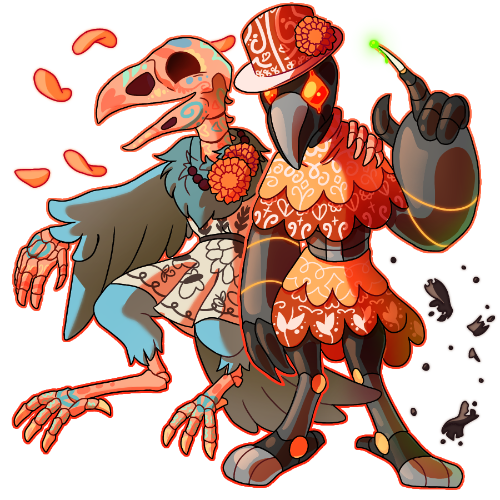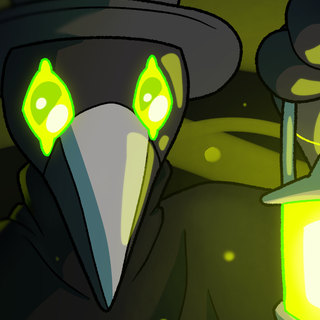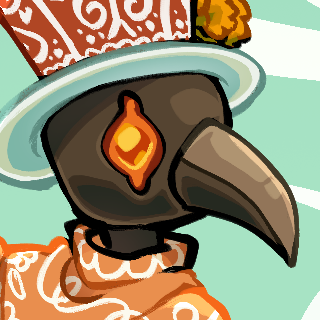[Cosmosdex] The Universal Encyclopedia
[Cosmosdex]
Yersinia
Marigolds / Morticians
Yersinia

Art by, Chimerii
- Strength-2
- Intelligence-10
- Charisma-5
- Endurance-1
- Agility-4
- Luck-4
Common Jobs: Medic, Biologist, Roboticist
Likes: Death, Color, Flowers, Knowledge, Festivals
Dislikes: Decay, Darkness, Cold
Attack Method: Peck and claw at the foe. Morticians can regurgitate their rotting insides in an attempt to infect the foe.
Attributes
Homeplanet: CheopiaLifespan: 100 years
Size: 7 ft tall
Diet: Plants, Insects
Bodytype: Tailed Bipedal
Type: Arthronoid Avian
Social Class: Lower High Class
Rarity: Extremely Rare
Common Traits
This character loves the holidays and will be glad to mention them when they come up. They may be so into holidays they will know the holidays being celebrated on other planets and the traditions attached to them.
This character doesn't lose morale as fast and can never hit negative morale. No matter what the situation, this character will keep their head up high and may raise the morale of others. The optimistic trait may drain sanity if the character is in a bad situation for a long amount of time.
This character will always try to back down from a fight, though they will still act in self-defense if they don't have a choice. If forced into dangerous situations, they will suffer morale loss, and will be more inclined than most to abandon their crewmates.
Physical Description
Yersinias are flightless, bipedal avians with an exposed skeleton on their neck, head, hands, lower legs, and feet. These bones have hidden muscles and ligaments inside it that allow them to function like the rest of the body- yersinias essentially have exoskeletons in these regions and only in these regions. They often resemble corvids and vultures, but can take the shape and skulls of other birds.
They are brightly colored and their exposed bones are often a different color from their feathers. Their feathers are usually not patterned but can be, but their exoskeletons, which are only white in an uncommon variant, have natural markings alike sugar skulls. They have a ruff of feathers at their neck and feather tails of varying length.
Yersinias wear clothes as often as they do not. Their clothing is generally frilly and intricately detailed. If possible, they will wear clothes customized towards the wearer, bearing unique embroidered text and patterns.
A yersinia will almost never be seen without flowers on them, pinning it to their clothes, wearing it in satchels and as necklaces and bracelets, and more. The marigold is, by far, the most common flower to be worn on a yersinia, yet they will wear different flowers to convey different messages.
They are adults at 20 and lay eggs in clutches 2-3 large. Young yersinias have skin, feathers, and flesh around their exoskeletal parts, but they serve no purpose other than warmth and padding. Their eyes are the only functional part adolescents have that they soon lose, as it and all of their extra flesh sloughs off as they reach adulthood. Yersinias lose their childhood eyes, but adults see through pure black, hidden eyes placed in the back of their shadowy eyeholes.
When a yersinia predicts they will soon die, whether from age, illness, or any other reason, they will enter robotic suits known as "morticians". The mortician suit locks as soon as someone steps inside it and it is impossible to leave- they die within the suits. However, their limited time alive in the suit allowed for yersinias to copy and digitally upload their consciousness to the mortician with the cranial tech inside it. Once a yersinia dies in a mortician suit, the mortician will load its saved personality and become a sentient, autonomous AI with a mind that is a digital copy of the corpse it contains.
Morticians are black or dark grey with colorful highlights. They retain the body shape of yersinias but are featherless. They wear flower-like shawls, and skirts, dresses, or gowns. They frequently wear some kind of hat and/or veil. Their clothing is bright and intricately patterned. Like living yersinias, they wear flowers. Their faces, with glowing, diamond-shaped eyes, are unable to emote except for a movable jaw piece.
In death, morticians are born doctors. The yersinia corpse inside them will begin to rot, and they use this to their advantage to treat others. As bacteria festers inside them, internal hardware is able to study and convert the bacteria into working and administerable antibodies. Through retractable needles in their clawtips, morticians are able to give people efficient and home-grown medicine. Even without a medbay or most typical resources, they are able to at least partially treat most infections.
Morticians thrive on internal filth and disease. During and after their body's decomposition, they will "ingest" flesh by dropping it into their hollow insides through the mouth. This allows them to maintain bacteria cultures even after their yersinia corpse has fully decayed. While morticians are safe to touch and only have an extremely low chance of getting someone sick while intact, any ruptures in its shell will make it virulent towards anyone around it.
Living yersinias smell floral and pleasant as described by most species, but morticians stink of pestilent rot. The beak part of their shells emanate strong perfumes in an attempt to mask the smell, which is only partially effective. Most by them would describe them as exactly they are- the unnerving result of someone trying to hide a much darker aspect of them.
While morticians are a mostly stable method of copying someone's personality, over time, between the length of a mere few years to centuries, they can "decay". Decayed morticians often have worn and peeling paint, and most if not all of their colorful highlights have faded away into blacks and dark greys. Their clothing, too, has faded colors, and are often greyscale. They do not wear flowers, and any offers to repaint them or adorn them with blooms will be rejected, too apathetic and aloof to want it or believe they should have it.
The living yersinias who craft mortician suits have tried their best to remove personality decay, but it remains for reasons incomprehensible to them.
They can only shake their heads and say, "Perhaps that's just how the afterlife works."
Personality
Living yersinias are frequently described as pleasant, studious, and festive. Most morticians, literal animated corpses, are described as cold, aloof, and emotionless.
The concept of life is one that yersinias hold highly. They live in the moment and would rather do something now than later, after ages of pondering it; they're a decisive people. They spend great amounts of time as scholars after knowledge, studying competitively to become the most educated, but rarely do they let any shortcomings consume them.
They often represent aspects of their mood and culture through flowers, and flowers and flower symbolism can be found on their homeplanet, clothing, and living spaces. They closely follow the language of flowers, that being their symbolic meanings. To them, it's a second language and a shame if one has not heard of it. Visual art in general is emphasized in their culture and they dislike using drab colors.
Yersinias strongly believe in the afterlife and that morticians are living it. Most yersinias try to keep up a variety in the types of flowers they wear, but marigolds are the most commonly worn. They are treated as a bridge between life and death, and yersinias celebrate death as much as they do life.
While yersinias are generally described as friendly and accomodating, they have been noted by the wider universe to be disturbingly morbid at times. Yersinias, though not seeking it out, are rarely terrified of death and are prone to reflecting that in their speech and actions. They see morticians, the walking corpses of their species, as good luck and regard them with little of the fear that might be ordinarily directed to it.
Morticians are robots with AI personalities that are an exact copy of the yersinia that died within it. They start out with the exact same disposition as a living yersinia and are generally happy to be dead. They adapt to their new bodies easily and see their "new life" in the underworld (the universe through the eyes of a robot) as a time for resolutions and building themselves into better people.
There are some hard-coded differences between morticians and living yersinias. Morticians feel a need to always have something rotting inside them and will compulsively "eat" flesh to sustain this. When aware that there is some kind of disease around them, they will feel some kind of pull to go and at least try to treat it, though this urge can be fairly easily ignored. While not specifically hard-coded, morticians are aware that punctures in their shell will spread disease and will often be fittingly mortified to be the cause of what they want to stop.
The mortician remains an exact copy of the dead person it contains for many years, even after the corpse has long decomposed inside it. However, with time, the hardware for the AI will start to deteriorate and decay, massively changing the mortician's personality. While all their memories remain intact, a decaying mortician will gradually start to lose all emotion. They fear this process and are aware of when it happens to them, but they cannot stop it. They become apathetic towards everything, including themselves, and their urge to treat diseases becomes the only thing they feel. As such, they will rarely ignore it.
Decayed morticians are by far the most common type of yersinia, living and dead. As more yersinias die and more morticians decay, their numbers only stack up with each generation. Despite their emotionlessness, which can make them come off as cold and aloof, they still retain morals and will generally try to act in what they believe to be the best for everyone around them, even if they do not particularly care about what happens to themselves.
The relationships between yersinias and morticians are generally good. Yersinias celebrate passing onto the afterlife and morticians celebrate being in it. Funerals are jovial events in which the yersinia adorns the new mortician with marigolds and all other kinds of flowers. A yersinia not being loaded into a mortician suit before it dies is a tragedy, and they will try to avoid such a devastating event as much as they can.
Things become strained with yersinias and decayed morticians. Yersinias often try to see the best in life, yet decayed morticians are functionally a ghost in terms of personality. While they still have likes and dislikes, they will indulge in them far less and only because "they used to feel that way about them." Though yersinias see becoming a mortician as the afterlife and celebrate it, they are often still horrified by mortician decay and cannot comprehend that the afterlife would end in something so atrocious from their perspectives.
If they notice a mortician is starting to decay, yersinias will often do everything they can to "remind" them of the vigor of life and the afterlife. They'll try to take the mortician to things they enjoy, will try to go through old photos reminding them of happy moments, all in vain. There's no celebration for when a mortician starts decaying and it is a mournful process.
They treat fully decayed morticians with the same respect one would normally give a departed person. Though it's cultural to give a mortician flowers and treat them the same as they were when alive, yersinias generally respect a decayed mortician's wishes not to live in the color and energy they had before decay. They simply let the dead rest.
History
Yersinias were a well-developed species that became overtaken by a plague. It spread quickly across their planet through planes and seaships and cars, and it was deadly. Their numbers started to reduce and many feared it would be the end for their species.
Fearing that any medics their race had left would soon perish, skilled roboticists devised a suit that would allow them to continue their work, even post-mortem. The mortician suits were quickly approved and delivered worldwide as one of many last-ditch efforts to save themselves.
Morticians were extremely effective. Their black metal stood out among the colorful and ailing crowd and made them beacons of medicine. As expected, most remaining doctors did die, but morticians alleviated the cost of the fall greatly. Over time, with them and multiple other efforts, the yersinias' plague was soon eradicated.
Recovering from the massive losses was difficult. Yersinias found comfort in believing that at least the dead were now in the afterlife where they would be happier. Morticians were only seen as ordinary, if not helpful AIs that were copies of the people they once knew.
But despite belief in the afterlife, they became scared of dying just as so many others did. Mortician suits, originally built just for use by medics during the plague, were what they turned to as an alternative, believing that maybe it could save them all from death. It became more and more common for a dying yersinia to enter them and live on as an AI until it was the utter norm on their homeplanet and a taboo to not do so.
Culture shifted with this monumental societal change. While yersinias once believed the afterlife to be in an ethereal, otherworldly realm, they gradually started believing that it was morticians themselves that were the afterlife, and any who died without becoming one simply had their soul cast out into nothingness. Death was now tangible to them and the afterlife simply became the universe through the eyes of a robot.
Eventually yersinias reached the space age and made themselves a registered species. While their living members were accepted without much trouble, as they contributed several highly-educated scientists and were in general a peaceful species, the gore and disease and horror of the morticians that yersinias adored directed universal horror to their AI kin. Debates also arose in that, since morticians were AIs, if they should even be considered yersinias at all. The medicinal properties of morticians proved valuable enough that they were tentatively given a legal slot alongside the higher-class living yersinias.
More time passed, and morticians started to notice personality changes in themselves, as did the yersinias who were watching. The oldest morticians started to decay, and suddenly the yersinias' concept of the afterlife didn't look as perfect as it seemed. At first they thought it was an error in the suits, so they had scientists try to correct any flaws. Morticians kept decaying.
They tried every other method they could think of to avoid watching the souls of their brethren fade to nothing. Morticians kept decaying, and yersinias had to face true death yet again.
Home Planet
Cheopia is a bright and floral planet filled with mostly prairies and many rivers. Yersinias grow countless flowers on it, and nearly every building is adorned with colorful blooms. Most cities are clean and highly developed, and there are many living yersinia and mortician-run hospitals.
Most cities have a mass grave as a memorial to the great plague that spawned the morticians. They are solemn sites, but modern funeral homes on Cheopia are filled with partying and joviality.
Subspecies
None / Unknown.
Special
Postmortem: Upon death, if allowed to do so, a yersinia's consciousness will live on through a mortician AI. Morticians are generally off-putting, cannot make complex facial expressions, and if their shell is punctured, become virulent until repaired. However, they have the inherent ability to create and administer treatment for most infections. Over time, generally after a few centuries, morticians will decay and lose all emotion.
Trivia
• Morticians hold a lower social class than yersinias. Additionally, due to their tendencies to "eat" flesh, they are frequently mistaken for clockworks. Setting them on fire has slightly reduced effects compared to a normal robot, as they and their clothing was built to withstand extreme heat in order to burn off disease.
• As adults in the workforce, many yersinias go into science and astronomically few into trade jobs- most manual labor has been replaced by automation in yersinia society, and many are remarkably clueless on how to operate power tools on first glance.
• Mortician suits are not built to transfer or run the consciousness of any species but yersinia. If someone else tried to step inside one, the suit would trap them inside and would not digitally revive them upon death.





